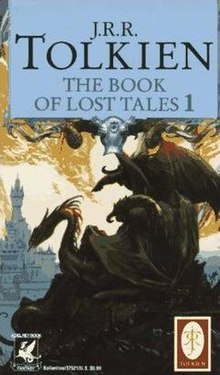The Book of Lost Tales

Volume 1, illustrated by John Howe
|
|
| Editor | Christopher Tolkien |
|---|---|
| Author | J. R. R. Tolkien |
| Country | United Kingdom |
| Language | English |
| Genre |
High fantasy Literary analysis |
| Publisher | George Allen & Unwin (UK) |
|
Publication date
|
28 October 1983 (Vol. 1) 16 August 1984 (Vol. 2) |
| Media type | Print (hardback and paperback) |
| Pages | 297 pp (Vol. 1, first edition) 400 pp (Vol. 2, first edition) |
| ISBN | (Vol. 1) (Vol. 2) |
| Preceded by | The Monsters and the Critics, and Other Essays |
| Followed by | The Lays of Beleriand |
The Book of Lost Tales is a collection of early stories by J. R. R. Tolkien, published as the first two volumes of Christopher Tolkien's 12-volume series The History of Middle-earth, in which he presents and analyzes the manuscripts of those stories, which were the earliest form of the complex fictional myths that would eventually comprise The Silmarillion. Each of the Tales is followed by notes and a detailed commentary by Christopher Tolkien.
For publication the book was split into two volumes: The Book of Lost Tales 1 (1983) and The Book of Lost Tales 2 (1984), but this is simply an editorial division. Both volumes are separated into several "Lost Tales".
Though they cover a broadly similar history, the Tales are very different from The Silmarillion. Firstly the Tales are more complex and detailed than The Silmarillion: they are written in a less formal but more archaic style and include many obsolete words and phrases. Secondly the interaction between the different elf-races is profoundly different: the exiled Noldoli (or "Gnomes", the Noldor of the later histories) suffer decisive defeat much earlier and become slaves of the enemy they had sought to punish. Thus when Thingol feels disdain for Beren it is because the latter is a gnome (not a mortal human) and therefore a thrall of Melkor.
While many of the names in the book are identical or close to those in the later versions, some of them bear almost no resemblance to their final forms. Tolkien changed names rather frequently, sometimes with several new variants (rejected in turn) written in a single manuscript. Confusingly, sometimes the name applied to one thing is later used to refer to something quite different, the original use abandoned. For example the house of Elves called "Teleri" in The Book of Lost Tales is not the same as that of The Silmarillion (see Teleri). The original usage of "Teleri" would eventually change until the name became "Vanyar", while the house of Elves called "Solosimpi" would inherit the name "Teleri".
...
Wikipedia
